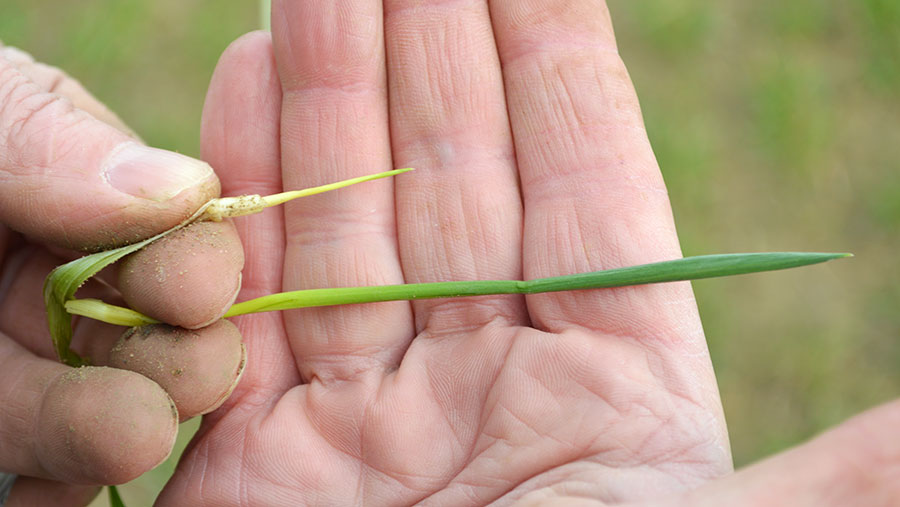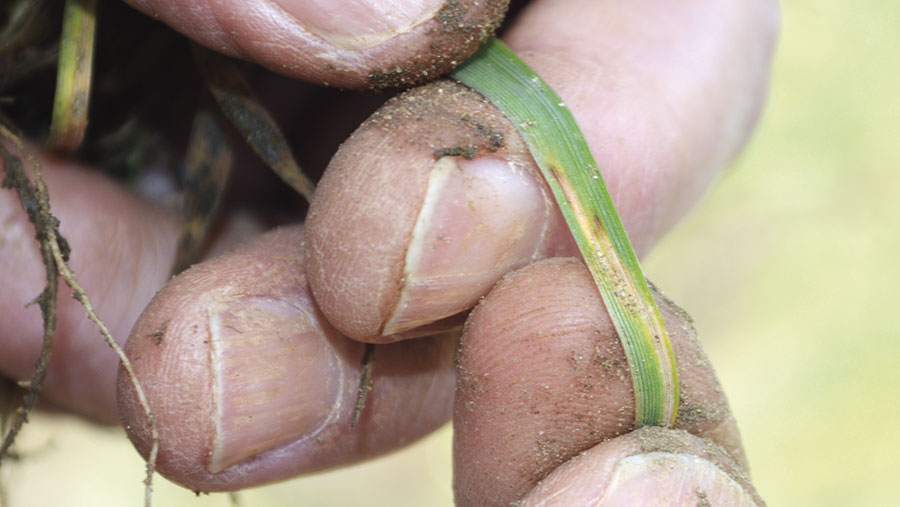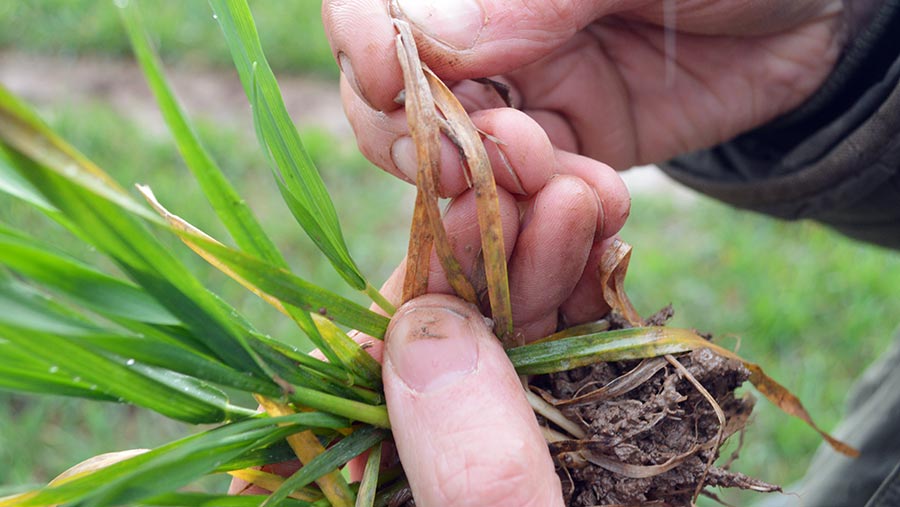Crop Doctor: Rust alert after tour of England’s wheat fields
 Jonathan Blake and Patrick Stephenson © David Jones/RBI
Jonathan Blake and Patrick Stephenson © David Jones/RBI Wheat growers should be focusing on rust diseases in the early spring, as controlling these will give a very clear benefit in higher yields.
Yellow and brown rusts established in many crops in the warm autumn and despite some sharp frosts in late winter, these diseases have not lost their potency.
Jonathan Blake, cereal disease expert at crop consultants Adas, said the late wet spring means workloads are congested and early fungicide sprays may be omitted, leaving a potential window for rusts to develop.
See also: Why SDHI fungicide strategies need to change in 2018
“I am most concerned about rust in the early season and the benefit of controlling rusts is very clear in yield terms,” he told Farmers Weekly.
Rust risk
If yellow or brown rusts are seen in winter wheat crops then he suggests using an azole or strobilurin fungicide as soon as a sprayer can travel on the land.
Patrick Stephenson, independent agronomist, said if a grower misses an early T0 spray, which this season is set to be in the first few days of April, then a robust T1 spray may be needed, including an SDHI.
“If growers miss a T0 spray, then they should look to move some of the T0 spend to the T1 application,” he said.
To assess the risk to crops nationwide, we took off on the Bayer Crop Doctor helicopter to travel to four sites across England with these two experts to give the latest advice for growers.
The team visited a yellow rust “hotspot” in south-east Lincolnshire, a septoria-susceptible site in Herefordshire as well as south Oxfordshire and North Yorkshire.
Mr Blake said the first step in septoria control will come with the T1 spray and here the declining effectiveness of the SDHI fungicides needs to be considered, as there is plenty of septoria being seen in early sown crops.
Sensitive septoria
Up to 40% of septoria is now less sensitive to SDHI fungicides and the disease’s increased resistance levels to these fungicides is a growing concern, he added.
The wet winter weather means septoria is likely to be ever-present, and further rain and wind in the spring could help it spread, and so growers need to keep the top three leaves of their wheat crops clean of the disease.
“In early sown crops, septoria can be seen in spades, whereas later-sown crops have much lower levels of the disease,” said Mr Blake.
Typical fungicide actives
- Aviator – SDHI bixafen + azole prothioconazole
- Adexar – SDHI fluxapyroxad + azole epoxiconazole
- Keystone – SDHI isopyrazam + azole epoxiconazole
- Vertisan – SDHI penthiopyrad
- Ascra – SDHIs bixafen + fluopyram + azole prothioconazole
- Elatus – SDHI benzovindiflupyr + azole prothioconazole
Mr Stephenson added that disease control decisions in his area of North Yorkshire are always driven by septoria, and so a T0, if applied, should be led by a protectant multisite fungicide such as chlorothalonil.
If a SDHI is deemed necessary at T1 in early-sown crops of susceptible varieties, then he advises keeping azole and chlorothalonil levels high to protect the SDHI in a mix.
Watch the short video reports from each of the four Crop Doctor sites below.
North: Cawood, North Yorkshire
Winter wheats in North Yorkshire looked desperately in need of some warm weather with these backward crops showing only a smattering of septoria disease.
On the most northerly of the four Crop Doctor sites, septoria was evident only on a few of the lower leaves with crops likely to come to the T0 fungicide timing at about 7-9 April.

© David Jones/RBI
The site at the Stockbridge Technology Centre near Cawood, 10 miles south of York, is on fertile silty clay soils close to the River Ouse and capable of producing high yields.
Watch the video report from the trials site at Cawood below.
North Yorkshire-based Mr Stephenson said T0s would be driven by the presence of rust. A multisite such as chlorothalonil would be used as a base protectant spray to give some control of septoria, and an azole, such as tebuconazole, added if rust was present.
His strategy for T1 at the end of April will be driven by variety choice and drilling date. With late-drilled crop of varieties with good septoria resistance such as Siskin and Graham, he would use an azole plus a multisite fungicide.

Adam Tidswell, Bayer © David Jones/RBI
However, for varieties with poor resistance to septoria such as the biscuit-making wheat Barrel, which is popular in Yorkshire, he would go for a more comprehensive SDHI-azole-multisite three-way approach.
Mr Blake added that septoria was the only threat at this stage on the small spindly plants with leaf four of wheat crop only about 20% emerged in the last few days of March. The T0 timing is when leaf four is fully emerged.
Adam Tidswell, Bayer’s commercial manager for Yorkshire, said the Vale of York site had seen heavy rainfall with 278mm of rain between drilling on 5 October and 27 March.
The cold frosty winter had helped control rusts and mildew, but septoria was “bubbling away” at the bottom of the crops, he said.
His advice was to use a multisite at T0 unless rust is clearly present, and then like Mr Stephenson, he would add in a rust-active azole.
West: Callow, Herefordshire

© David Jones/RBI
The wetter climate of Herefordshire was expected to give the highest levels of the wet-loving septoria across the four sites and it did not disappoint with the disease seen on the upper leaves.
Mr Blake, who is based in the county, said on early sown crops the disease was being seen on the second last leaf to emerge, which meant the top leaf could well be infected and simply not showing symptoms yet.
Watch the video report below from the trials site in Herefordshire.
“This is a high-pressure septoria site, showing high levels of infection and there will be a significant risk from this disease,” he said.
He added some growers may use a multisite at T0 to give “peace of mind” for some control of septoria, while his thoughts on T1s were for a full SDHI-azole multisite for early-sown septoria-susceptible varieties, and an azole-multisite for later sowings of more resistant varieties.

Gareth Bubb, Bayer © David Jones/RBI
Mr Stephenson remarked Herefordshire crops were nearly a full leaf ahead of those in Yorkshire, with leaf four fully emerged while it was only 20% emerged on the Yorkshire site.
The trial site at Monkhall Court, Callow, is on a rich red Herefordshire loamy soil some three miles south of Hereford city and close to the River Wye.
Gareth Bubb, Bayer’s commercial technical manager for Herefordshire, said a trial on the site emphasised the big difference in drilling dates which were only 10 days apart – comparing a late September sowing with an early October one.
“The September-sown crops show more leaf, more disease and hold out a bigger lodging risk,” Mr Bubb added.
He believed septoria risk was the key factor in winter wheat variety selection in his area, with those with a resistant score of 6 or above doing well in the county.
Local independent agronomist David Lines agreed and said in Herefordshire, varieties with good resistance to septoria had proved popular with Graham looking good for early drilling, while Siskin, Costello and Skyfall also did well.
South: Hinton Waldrist, south Oxfordshire

© David Jones/RBI
Active septoria was visible across most variety plots at a wet Oxfordshire site giving the potential for serious disease pressure to build up through the spring.
Mr Blake pointed out septoria is often seen at this site in south-west Oxfordshire close to the River Thames due to the wet weather, and he picked up the disease across most of the varieties.
“There is a serious septoria risk, not quite at the level seen in Callow as it is generally one leaf behind the Herfordshire site,” he said.
The site at Duxford Farm, Hinton Waldrist is 12 miles south-west of Oxford on the fertile flood plain of the Thames, where there was plenty of signs of waterlogged fields.
Watch the video report below.
Mr Stephenson agreed there was potential of high septoria and again pointed to the need for growers to switch to those with good disease resistance.
Mr Blake said growers should keep an eye out for yellow rust and treat crops with a multisite – with an azole added only if rust is present.

Ben Giles, Bayer © David Jones/RBI
The site was drilled relatively late, on 12 October, and with a lower disease pressure than Herefordshire, a T1 azole-multisite approach could be appropriate with varieties with good disease resistance.
Ben Giles, Bayer technical manager, said most varieties were showing septoria, but it was very difficult to see the disease in the new variety Sundance, which has the highest level of resistance to the disease.
“You can pick out Sundance in the trials field as we could not see any septoria,” he said.
The variety was useful in the fight against the disease, although he did point to three weaknesses – poor lodging, low specific weight and poor eyespot resistance.
East: Long Sutton, Lincolnshire

© David Jones/RBI
David Hoyles believes his wheat crops are three weeks behind normal although he has the bonus of very low disease pressure on his farm in south-east Lincolnshire.
This farm site just three miles from The Wash has generally low rainfall and is a “hotspot” for yellow rust, due to its warm and humid conditions, although in practice septoria is often a bigger threat.
Watch the video report from Mr Hoyles’ farm below.
He has seen very little disease in his winter wheat, largely in varieties with good disease resistance such as Graham, Motown and Freiston.

David Hoyles © David Jones/RBI
He is planning to go with a T0 in the first week of April as he is set to apply a plant growth regulator and micronutrient and so may add in a multisite to keep septoria under control.
Mr Stephenson pointed out that the variety Graham has seen a problem with some strains of yellow rust so he might advise adding an azole, such as tebuconazole, in the mix, while Mr Blake said if the rust risk is low he may get away without any T0.
“There are few bits of septoria so I would be tempted not to use a T0 as less disease susceptible varieties area being grown,” said Mr Blake.
A few spots of septoria could be seen in the wheat variety plots, but as Mr Hoyles explains, he can act quickly as he can get around all his wheat in one day with his sprayer.
He is planning to use just an azole-multisite for T1 on some of his wheat to allow him to experiment with an SDHI at T3, which he thinks may be useful to prolong growth on this high-yielding site. It is not permitted to use more than two SDHIs in a season to try and protect these valuable fungicides.
“We are going to try an SDHI at T3 to see if we can extend the life of the crop and see if this can lift yields,” he said.
Mr Hoyles grows 180ha of winter wheat on his 700ha Monmouth House Farm, Lutton, 12 miles east of Spalding, and aims for high yields on his rich fertile silty soils and his top yield in the good harvest of 2015 came in as high as 15.6t/ha.

